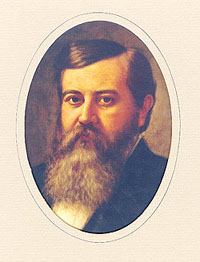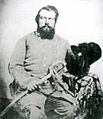Richard B. Hubbard facts for kids
Quick facts for kids
Richard Bennett Hubbard, Jr.
|
|
|---|---|
 |
|
| United States Minister to Japan | |
| In office 1885–1889 |
|
| President | Grover Cleveland |
| 16th Governor of Texas | |
| In office December 1, 1876 – January 21, 1879 |
|
| Lieutenant | Vacant |
| Preceded by | Richard Coke |
| Succeeded by | Oran Milo Roberts |
| 16th Lieutenant Governor of Texas | |
| In office 1874–1876 |
|
| Governor | Richard Coke |
| Preceded by | Vacant |
| Succeeded by | Joseph D. Sayers |
| Personal details | |
| Born | November 1, 1832 Walton County, Georgia |
| Died | July 12, 1901 (aged 68) Tyler, Texas |
| Resting place | Oakwood Cemetery, Tyler |
| Political party | Democratic |
| Spouses | Eliza B. Hudson (1858) Janie Roberts (1869) |
| Alma mater | Harvard University |
| Military service | |
| Allegiance | |
| Branch/service | |
| Years of service | 1861–1865 |
| Rank | |
| Commands | 5th Texas Infantry Battalion 22nd Texas Infantry Regiment 1st Brigade, Greyhound Division |
| Battles/wars | American Civil War |
Richard Bennett Hubbard, Jr. (born November 1, 1832 – died July 12, 1901) was an important figure in Texas and American history. He served as the 16th Governor of Texas from 1876 to 1879. Later, he became the United States Envoy (a type of diplomat) to Japan from 1885 to 1889. Hubbard was a veteran of the American Civil War, fighting for the Confederate side. He was also a member of the Democratic Party.
Contents
Early Life and Education
Richard Bennett Hubbard, Jr. was born in Walton County, Georgia. His parents were Richard Bennett and Serena (Carter) Hubbard. He spent his childhood years in Jasper County, Georgia.
In 1851, Hubbard graduated from Mercer Institute with a degree in literature. He was highly honored there, being chosen as the National University Orator. After Mercer, he briefly studied at the University of Virginia. In 1853, Hubbard earned a law degree from Harvard University.
After finishing his studies, Hubbard and his family moved to Smith County, Texas. They settled first in Tyler, Texas and then on a large farm near Lindale, Texas.
Starting in Politics
Hubbard began his political career in 1855. He spoke out against the American Know Nothing Party. In the 1856 presidential election, he supported James Buchanan. When Buchanan became president, he appointed Hubbard as the United States Attorney for western Texas.
Hubbard left this job in 1859 to run for the Texas legislature. He won the election and became a strong supporter of Southern secession. This meant he believed Southern states should leave the United States.
Serving in the Civil War
After the Southern states seceded, Hubbard tried to get a seat in the Congress of the Confederate States, but he was not successful. He then began gathering soldiers to form a military unit. This unit became the 5th (Hubbard's) Texas Infantry Battalion, and he was its leader.
Even though it was hard to find infantry soldiers in Texas, his battalion joined a larger regiment in March 1862. Hubbard became a major in the 22nd Texas Infantry. He was quickly promoted to lieutenant colonel in May and then to full colonel on June 17, 1862.
His regiment stayed in the Trans-Mississippi Department and was sent to Arkansas. There, it became part of the 1st Brigade of Walker's Greyhounds. This was a division made up only of Texas units, led by Maj. Gen. John George Walker.
Hubbard fought in several battles, including the Battle of Young's Point. After serving on a military court, he returned to his regiment. He then took part in the Red River Campaign and later fought at Jenkin's Ferry. In February 1865, back in Texas, Hubbard was put in charge of the 1st Brigade. He was officially released from military service on July 12, 1865.
Political Career After the War
After the Civil War, Hubbard worked as a lawyer. He also earned money from real estate and helping to promote railroads. These activities allowed him to return to politics by 1872. That year, he was chosen to support Horace Greeley for president.
Hubbard was elected Lieutenant Governor of Texas in 1873 and again in 1876. He became Governor of Texas on December 1, 1876. This happened when Governor Richard Coke resigned to become a United States Senator.
Governor of Texas
During Hubbard's time as governor, Texas faced money problems after the Civil War. There was also a lot of lawlessness. The state legislature did not meet during his term. Even though his political rivals stopped him from being nominated for a second term, people in Texas still liked him.
As governor, he achieved several important things:
- He helped reduce the state's public debt (money owed).
- He worked to stop land fraud (people illegally taking land).
- He supported improvements in education.
- He brought the state prison system back under public control.
Diplomat in Japan
In 1884, Hubbard was the temporary chairman of the Democratic national meeting where they chose their presidential candidate. He supported Grover Cleveland, who won the presidency. In 1885, President Cleveland appointed Hubbard as the United States Minister to Japan.
Hubbard spent four years in Japan. This was a time when Japan was changing a lot. It was moving away from an old system and wanted to be seen as an equal by other countries. Hubbard strongly supported Japan's desire for equal diplomatic standing.
He helped create a treaty with Japan for returning criminals (extradition treaty). His early work on general treaty changes also helped set the stage for new treaties in 1894–99. When he returned to the United States in 1889, he wrote a book about his experiences called The United States in the Far East, which was published in 1899.
Personal Life and Legacy
Richard Hubbard was a Baptist and a Freemason. He was also on the Board of Directors for Texas A&M University. In 1876, he was chosen to represent Texas at the World's Exposition in Philadelphia, Pennsylvania. There, he gave a famous speech encouraging national unity and goodwill.
Hubbard was married twice. His first marriage was to Eliza B. Hudson on November 30, 1858. They had one daughter, Serena, who survived. His second marriage was to Janie Roberts on November 26, 1869. Janie passed away while Hubbard was in Japan, leaving him with a second daughter, Searcy.
Hubbard spent his last years in Tyler, Texas, where he died on July 12, 1901. He is buried in Oakwood Cemetery in Tyler.
The town of Hubbard in Hill County is named after him.
Images for kids



